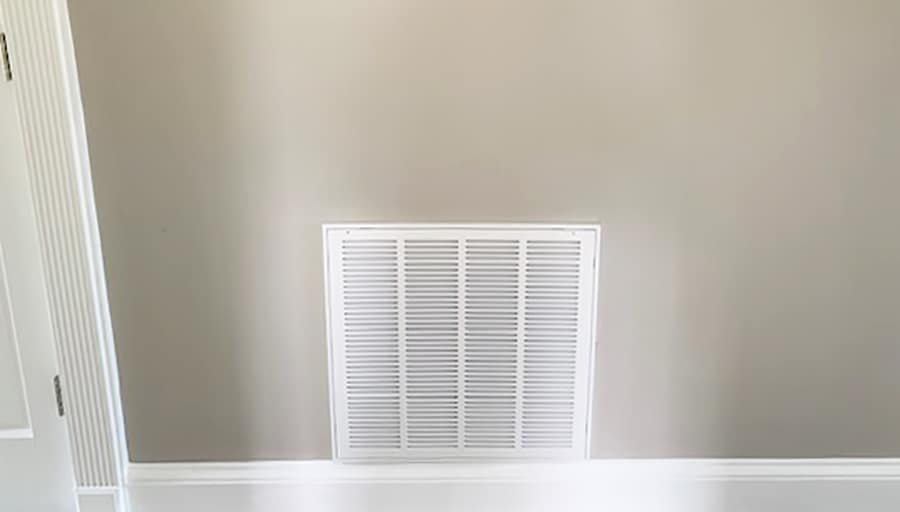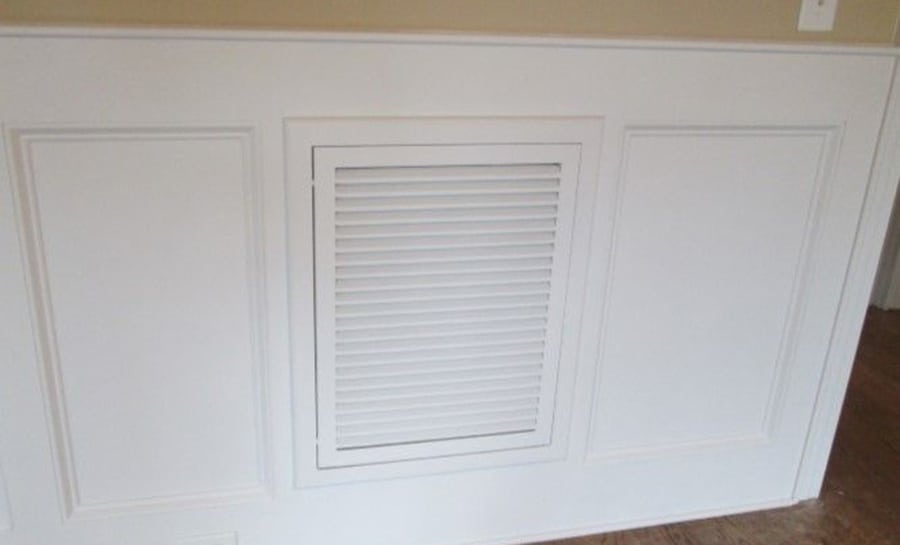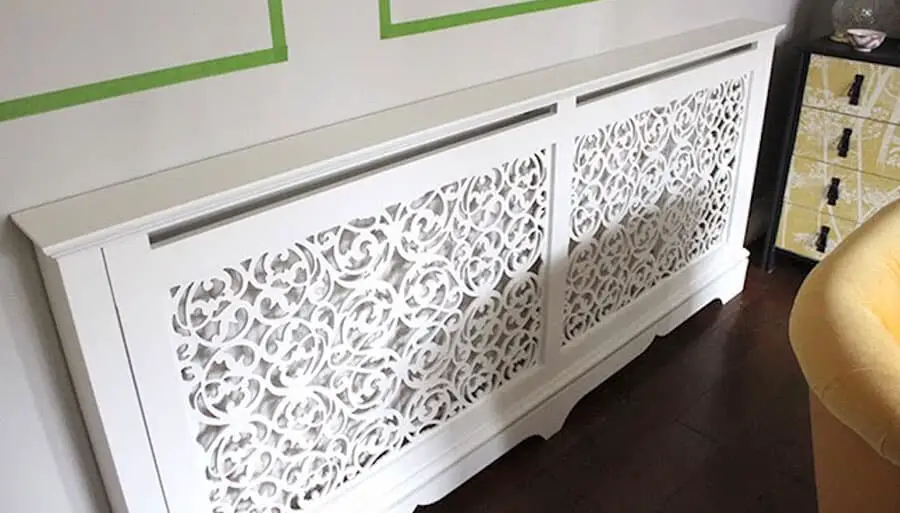
The air return vent is an essential component of your heating and cooling system. However, they are not pretty to look at, resulting in many people looking for ways to hide them.
You may be wondering if you can hide a return air vent without obstructing airflow. There are ways to hide your return air vent without impeding airflow. It’s important not to block your return air vent because your HVAC system needs constant return air to work properly. Blocked air return ducts will cause your system to lose energy efficiency and cause premature failure of your HVAC system.
This does not mean you don’t have many options for hiding your return air vent. This article will discuss ten ways to hide your return air vent without obstructing the air movement to your heating and cooling system.
Is it Ok to Cover a Return Air Vent?
A return air vent is a critical component to ensuring your heating and cooling system works properly. Blocking return ducts can cause the HVAC system not to operate efficiently and cause premature damage to the components inside your HVAC system.
Let me explain. The air handler (or furnace) portion of your central heating and cooling system is equipped with a blower fan. This fan draws indoor air from the house through the return air vent. The incoming air then flows over the evaporator coil, where it is either heated or cooled before air flows into the supply duct, where it is distributed back into your house via the supply air vents.
How Much Space Does a Return Vent Need?
The minimum clearance is 6 inches of space in front of cold air returns. However, this is often not enough. I generally recommend that the return vent have a minimum clearance of 12 inches in front, 12 inches on each side, and 6 inches above and below the return vent. This allows for enough air space on all sides for the return vent to draw in air for proper operation.
Due to the downward slight on the louvers in the standard grille cover (some grilles do not have louvers) the most important clearance space is in front of and below the return grille.
What Happens When Your Return Air Vent is blocked?
When you block the return air vents, you shut all airflow into the heating and cooling system, stopping the airflow to your rooms in your house. This causes stress on the blower motor and other HVAC components, driving the system to work harder and wear out faster.
What is the Purpose of a Return Air Grille
The standard return air grille is a metal louvered door covering the return air duct opening. It also serves as a placeholder for return vent filters.
Typical metal louvered grille comes in various sizes and comes typically painted white. However, this is only a basic design. Decorative metal grilles or custom-built wood air return grilles can serve the same purpose and look better doing it.
Can You put Furniture in Front of a Return Vent?
Most people would tell you, no, you cannot put furniture in front of an air return vent. However, that is not entirely true. It often depends on what type of furniture you place in front of the return air vent.
For example, you can’t place a couch or chair or any piece of furniture that has a back into it in front of a return air vent because it will block all airflow into the return air vent.
Some furniture, such as end tables or shelving open on all sides and bottom, would not obstruct the airflow into the return air vent. Custom pieces are fine, too, provided they meet these requirements.
The bottom line is as long as the furniture piece is open on all sides and the bottom allows the return air vent to draw in air to the heating and cooling system unobstructed, it should be fine.
Let’s look at ten creative ways you can hide your ugly AC return vent in your home.
10 Creative Ways to Hide Ugly Return Air Vents
Here are 10 ways to hide ugly air vents without obstructing air flow to the cold air return.
Ladder Shelving
Ladder shelving has become popular in recent years. Ladder shelving is open at the bottom, has no backing, and is open on the sides. Depending on the design, it leans up against the wall and either stands on its own or is secured to the wall at the top.
Since ladder shelving is primarily open, it creates enough space for unobstructed airflow into the air return. The key is not to place baskets or clutter the shelves to the point that airflow is restricted.
Custom-Built Wood Return Cover

I found this idea on Pinterest from DesignerTrapped.com. It involved some minor carpentry skills; however it is a do-it-yourself project. It consists in building a custom wood frame and using decorative metal sheeting cut to fit.
On their website, they include a complete materials list and how-to videos. The finished product looks great.
Bifold Louvered Doors
Bifold louvered doors have been recently used as a decorative item to provide screening and create a focal point to hide areas in your home.
Some of these bifold louvered doors are antique, while others are modern. The key is that they are louvered and allow airflow through the louvers and on the top and sides.
Bifold louvered doors come in a variety of heights and widths. These doors often stand in place on their own by forming a Z or W pattern, depending on if you use 3 or 4 louvered panels.
If your return air vent is located in the room, such as a living room, a set of louvered may be just what you need while also providing a focal point of interest.
Louvered Shutters
Much like the louvered doors, louvered shutters can be used to hide a return air vent without obstructing airflow.
These can be hung over the return vent like a picture would be or secured to the wall with hinges allowing you to open and close the shutters when it’s time to replace your return vent filters.
Blend-In with Faux Wainscoting

This method involves hiding the return in plain sight by adding a chair rail and wood trimming the same size as the return around the room and painting the entire area white.
This method draws your eye to the woodwork rather than the return vent itself. The return vent fades into the background and is barely visible unless you know it’s there.
Decorative Metal Grill Cover
This method is not necessarily a means of hiding the return air vent. It makes it a focal point in the room.
It turns a boring white louvered return vent door into a work of art. You can purchase these custom-made return air vent grills online through Etsy and other custom shops.
These decorative metal grills are somewhat pricy, but they are generally easy to install as a simple replacement for the existing door that you already have.
You can also use a decorative metal radiator screen that sits in front of the cold air return vents.
Narrow Sofa Table
We briefly mentioned furniture earlier in this article. Pieces of furniture that you could use in front of a return air vent is a narrow sofa table, or some people call it a foyer table.
These narrow tables usually are about 12 inches in width, have open sides, and are open on the front and the back. This means you could place the table in front of a return air vent without blocking the airflow into it.
Custom-Built Furniture Pieces

These furniture pieces are built with masking the return air vent in mind. These pieces are limited only by your imagination. They can vary in size, shape, and function.
You can find some examples at Freshome.com. As I said, though, these are just ideas. Maybe you can find an old antique piece that you could modify if you don’t want to build from scratch.
Repurpose Rubber Door Mats
This method has floated around the internet for a few years, but I’m surprised at those who’ve not seen it.
The premise is to mount rubber grated floor mats over the existing return vent. From afar this method looks good, but I’m not a fan of it close up. In my opinion, it just doesn’t look very professional.
The other problem is that these won’t cover all air return vents. Typically these rugs are about 18″ x 30″. Many return vents are over 20″ wide.
Blend-In the Vent with Paint
As Nike says, Just Paint It! Well, you know what I mean. One way to disguise the return air vent is to paint it the same paint color as the wall. The return air vent grille blends into the background in that painting, making it less noticeable.
This method has some drawbacks, as opening and closing the door on a regular basis to change your return vent filters could cause the paint to chip off. So don’t use latex paint. You’ll need paint designed for metal surfaces.
If you can get some tintable paint made for metal surfaces, you can obtain a smooth durable finish using a paint sprayer.
If matching paint isn’t an option, try using a fresh coat of metallic copper, pewter, or black paint to give a basic white grille some character.
In Closing
By now, I hope you understand the importance of the air return vent but also understand that you can safely hide the return air vent. You need to plan out your project and make sure you don’t restrict airflow to the return vent and allow for access to replace the return vent filters.
Please don’t forget to replace your changeable air filter. It’s easy to hide your return and then forget to change your air filter. Set a monthly reminder in your phone if need be.







